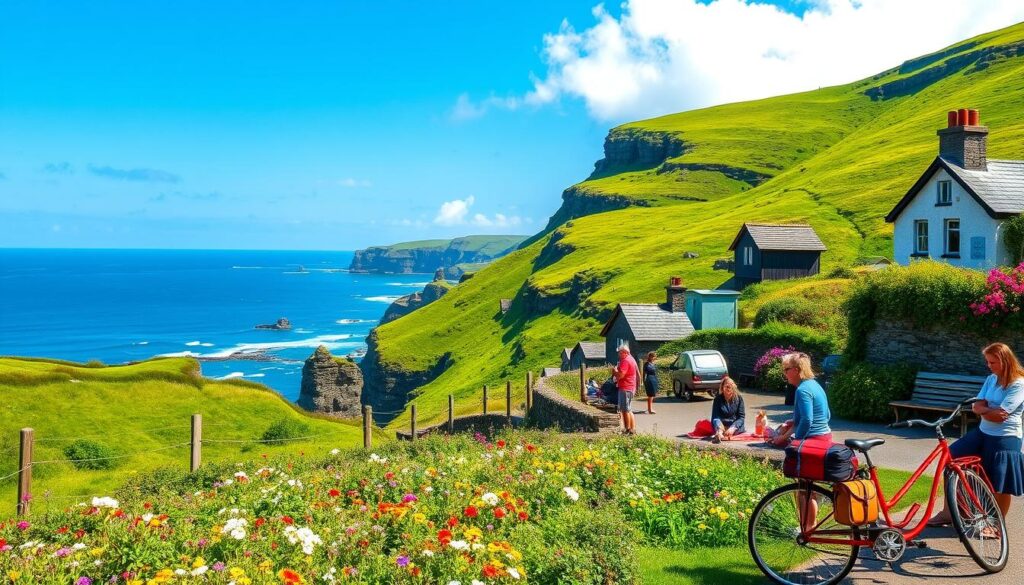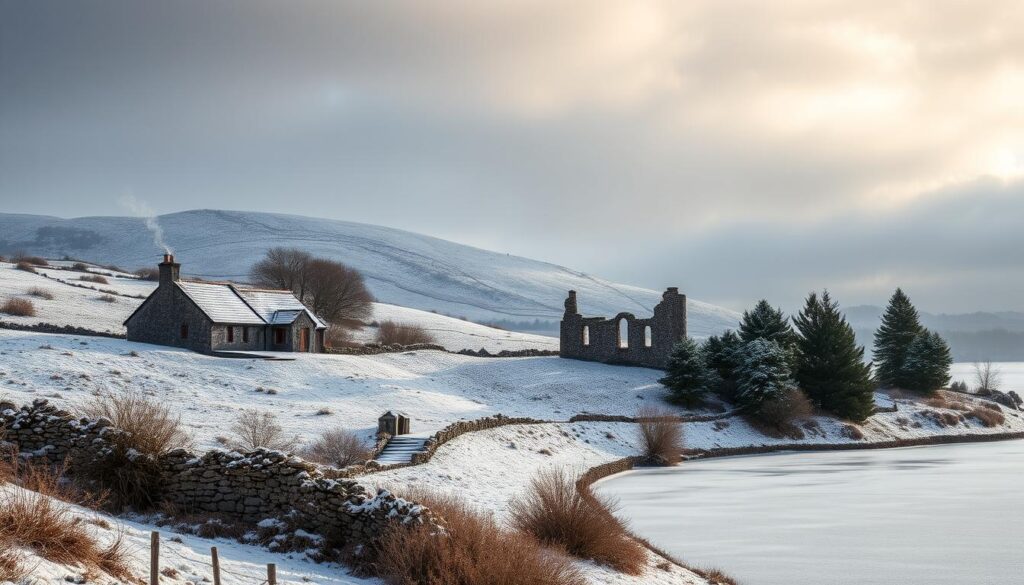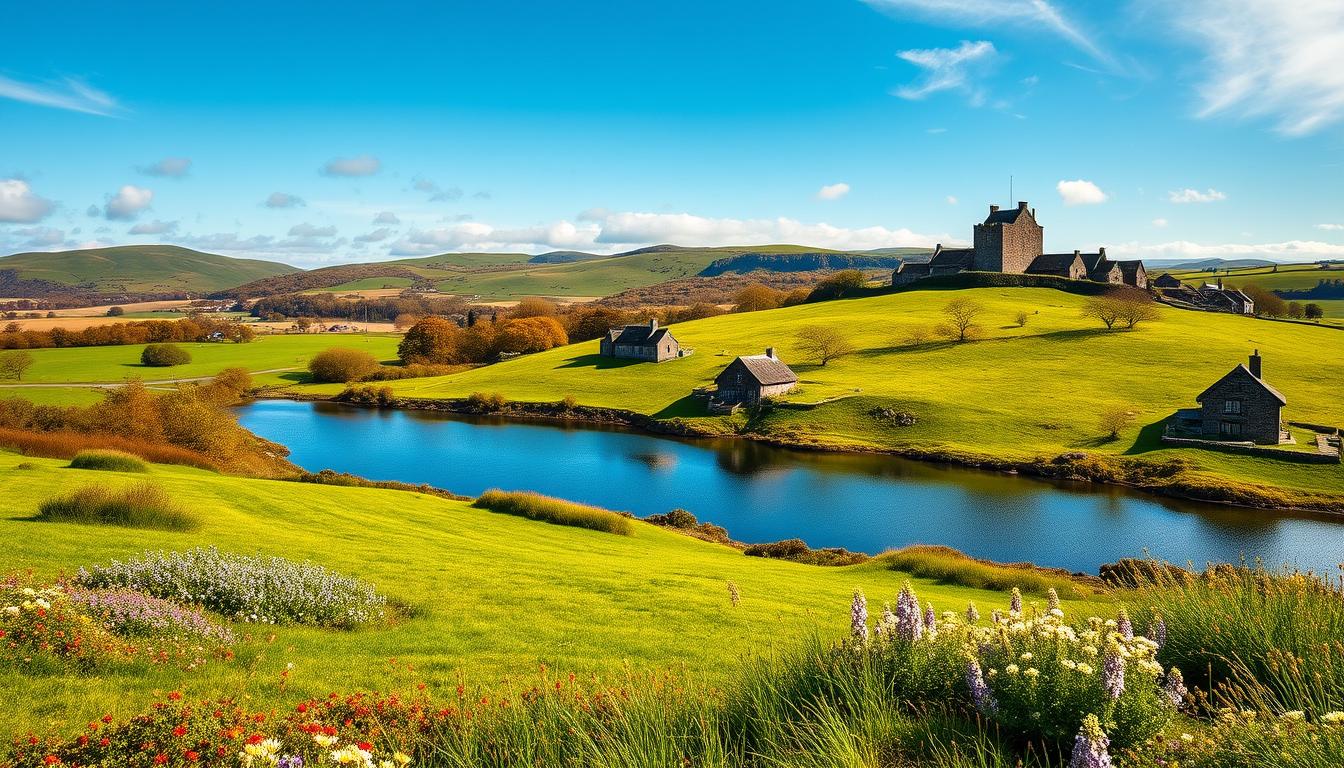Ireland is a beautiful place all year round. It has green landscapes and a rich history. The best time to visit Ireland depends on what you like to do. This guide will help you choose the best time for your trip.
Ireland’s weather is mild and nice. Spring and fall are the best times to visit. These months have fewer people and nice weather, perfect for seeing Ireland’s sights.
Summer in Ireland is warm and sunny. It’s great for outdoor fun. Winter is cool but not cold, making it cozy for enjoying Irish hospitality.
Key Takeaways
- Spring and fall offer the best balance of weather and crowds
- Summer brings warmth and numerous festivals
- Winter provides budget-friendly options and festive charm
- Ireland’s climate is mild year-round
- Each season offers unique experiences for travelers
Understanding Ireland’s Climate and Weather Patterns
Ireland’s weather changes a lot, making it interesting all year. The weather changes with the seasons, but stays pretty mild. Let’s explore the weather patterns in Ireland to help you plan your trip.
Average Monthly Temperatures
Irish temperatures are usually cool. In winter, it gets down to 0°C (30°F). In summer, it rarely goes above 22°C (70°F).
Summer, from May to September, is the warmest time. Temperatures range from 13°C to 18°C (55°F-64°F). Winter, from October to March, gets colder, with temperatures between 4°C and 8°C (39°F-47°F).
Rainfall Patterns Throughout the Year
Rain is always around in Ireland, making it green. The northwest gets the most rain, while the southeast gets the least. Some places even get up to 275 rainy days a year!
But, sunny days often win out, creating beautiful rainbows.
Regional Weather Variations
Weather in Ireland changes a bit from place to place. Temperature differences are small, but rain can vary a lot. The west, like the Dingle Peninsula, gets more rain than the east, like Dublin.
This makes Ireland famous for having all four seasons in one day. Every visit is a new weather adventure.
| Season | Average Temperature | Characteristics |
|---|---|---|
| Spring (Mar-May) | 4°C – 15°C | Longer days, blooming nature |
| Summer (Jun-Aug) | 10°C – 23°C | Warmest season, up to 18 hours daylight |
| Autumn (Sep-Nov) | 7°C – 16°C | Vibrant foliage, unpredictable weather |
| Winter (Dec-Feb) | 3°C – 4°C | Short days, occasional snow |
Best Time to Travel to Ireland: Seasonal Overview
Ireland changes with each season, offering unique experiences all year. Spring and fall are the best times to visit. They have nice weather and fewer people.
Summer is the busiest time, from June to August. It’s warm, with temperatures between 15-20°C (59-68°F). You can enjoy festivals, music, and outdoor fun. But, expect higher prices and crowded places.
Fall turns Ireland into a colorful world. From September to October, it’s quieter with about 12.5 daylight hours. It’s great for visiting castles and villages without the summer crowds.
Winter in Ireland is cold but special. Temperatures are 4-8°C (39-47°F), perfect for cozy pubs and festive fun. Some places in the countryside might be closed.
| Season | Temperature Range | Key Features |
|---|---|---|
| Spring (Mar-May) | 8-11°C (46-52°F) | Blooming landscapes, moderate crowds |
| Summer (Jun-Aug) | 15-20°C (59-68°F) | Peak tourism, festivals, longest days |
| Fall (Sep-Nov) | 12-15°C (54-59°F) | Autumn colors, quieter attractions |
| Winter (Dec-Feb) | 4-8°C (39-47°F) | Festive atmosphere, potential site closures |
May is a great time to visit Ireland. It has mild weather and beautiful landscapes. You’ll see Ireland in all its green glory.
Spring in Ireland (March to May)
Spring in Ireland is magical. The weather is mild, and the beauty is stunning. From March to May, the country comes alive with colors and events.
Spring Festivals and Events
Ireland’s attractions are at their best in spring. Saint Patrick’s Day on March 17th is a big deal. Dublin and Galway have parades that show off Irish culture.
There’s also Saint Brigid’s Day and Easter Monday. Each adds its own special touch to the season.
Blooming Landscapes and Wildlife
Spring turns Ireland into a colorful wonderland. Wildflowers cover the countryside, making it beautiful. The Wild Atlantic Way is full of life, with dolphins and falcons.
Newborn lambs in green fields are a symbol of Irish spring. It’s a heartwarming sight.
Easter Holiday Activities
Easter in Ireland is fun for families. There are egg hunts, parades, and more. It’s a great time to see historic sites and castles.
| Month | Average Temperature | Sunrise Time | Rainfall Days |
|---|---|---|---|
| March | 46°F – 54°F | 6:40 AM | 11 days |
| April | 53°F – 59°F | 5:30 AM | 11 days |
| May | 55°F – 61°F | 5:00 AM | 10 days |
Spring is perfect for visiting Ireland. The weather is nice, and there are fewer people. It’s a great time to see all the attractions.
Summer Travel Experience (June to August)
Summer in Ireland is full of life. You’ll find festivals, outdoor fun, and lots of daylight. It’s the busiest time for tourists, with people coming from everywhere. The weather is nice, with temperatures between 50-63°F in June.
Peak Tourism Season Considerations
Ireland gets very busy in summer. Prices for places to stay and flights go up. To avoid the crowds, visit early June or late August. The longest day of the year, June 21st, means you can see more sights.
Summer Festivals and Cultural Events
Summer in Ireland is filled with fun events. June brings the Cat Laughs Comedy Festival and the Westport Folk & Bluegrass Festival. August starts the harvest season with Lughnasadh.

Outdoor Activities and Attractions
The weather is great for being outside. You can walk by the coast, see old sites, or try water sports. Remember to bring a light raincoat for the occasional rain.
| Month | Average High Temperature | Sunset Time | Notable Events |
|---|---|---|---|
| June | 16-19°C (61-66°F) | Up to 11 pm | Summer Solstice, Comedy and Folk Festivals |
| July | 18-20°C (64-68°F) | Around 10 pm | Peak tourist season |
| August | 17-19°C (63-66°F) | Around 9 pm | Lughnasadh harvest celebrations |
Autumn Adventures (September to November)
Autumn in Ireland is special. From September to November, the country turns into a warm, colorful place. It’s the perfect time to see Ireland’s beauty without the crowds.
Temperatures start to drop, but it’s still nice outside. Daytime highs are around 62°F in September and 50°F in November. It might rain a bit, but it makes the scenery even greener.
Autumn is a treat for your senses. See the beautiful leaves at Killarney National Park or Powerscourt Estate & Gardens. Nature fans can watch red deer or go whale watching by the coast.
“Autumn in Ireland is like stepping into a living painting, where every turn reveals a new masterpiece of color and light.”
Food lovers will enjoy autumn’s flavors. Try wild mushrooms, duck, and fresh mussels. Don’t miss the Galway International Oyster Festival in September.
| Month | Average High Temperature | Average Rainfall | Daylight Hours |
|---|---|---|---|
| September | 17°C (62°F) | 60mm (2.4 in) | 12.5 hours |
| October | 13°C (55°F) | 70mm (2.8 in) | 10.5 hours |
| November | 10°C (50°F) | 80-100mm (3.1-3.9 in) | 8.5 hours |
Enjoy the cool air with outdoor fun. Hike in Connemara National Park or cycle through the countryside. Autumn is great for self-driving trips, letting you explore at your own pace.
As October ends, Ireland celebrates Halloween. It’s a magical time to see Ireland’s folklore and traditions.
Winter Discovery (December to February)
Winter in Ireland is special for those who love quiet places. From December to February, it turns into a cozy wonderland. It’s perfect for seeing Ireland’s attractions without the summer crowds.
Christmas and New Year Celebrations
The festive season in Ireland is magical. Christmas markets start in mid-November. Places like Cork, Belfast, Galway, and Dublin have amazing displays.
Irish pubs are warm and welcoming. They’re filled with Christmas cheer and family fun.

Winter Festivals and Traditional Events
January brings the TradFest music festival to Dublin’s Temple Bar. It’s a must-see for music fans. On February 1st, St. Brigid’s Day is celebrated with straw cross-making. It shows off Irish heritage.
Indoor Attractions and Activities
Winter is great for indoor fun. Museums, cozy pubs, and historic sites are perfect for cold days. You can also see the Northern Lights from Malin Head in the North.
Winter in Ireland is also good for your wallet. February is off-season, so you’ll find fewer people and better prices. Even though it’s dark, there’s still time for scenic drives and walks.
“Winter in Ireland is like a hidden gem, waiting to be discovered by those who appreciate its quiet beauty and rich traditions.”
Winter in Ireland has festive fun, cultural events, and beautiful landscapes. It’s perfect for anyone looking for a unique experience.
Budget-Friendly Travel Periods
Planning a trip to Ireland on a budget? Timing is everything. Ireland is amazing all year, but you can save money by picking the right time.
Off-Season Travel Benefits
Traveling off-season in Ireland has many benefits. You’ll see fewer people and get better deals. Winter, except for Christmas, is the cheapest time. May and August are also good, with nice weather and lower prices.
Accommodation and Flight Costs by Season
Prices change a lot throughout the year. Here’s a quick look at what you might pay:
| Season | Hostel (per night) | Hotel (per night) | Flight (from US) |
|---|---|---|---|
| Summer (Peak) | €50-€120 | €150-€250 | $800-$1200 |
| Spring/Fall | €30-€80 | €100-€180 | $600-$900 |
| Winter (Off-peak) | €20-€60 | €80-€150 | $500-$700 |
Money-Saving Travel Tips
Here are some ways to save money:
- Book places to stay early for cheaper rates
- Use public buses for cheap travel
- Check out free spots like national museums
- Try early bird menus from 5-7 PM
- Get a Leap card for cheaper public transport
A daily budget is usually €150-€250. With these tips and traveling off-season, you can see Ireland’s beauty without spending too much.
Popular Destinations by Season
Figuring out the best time to visit Ireland depends on what you like to do. Ireland has different attractions all year round. This caters to many different tastes.
Coastal Attractions
Ireland’s coasts are amazing from April to September. The Cliffs of Moher are a top spot in summer. The views are stunning when the sky is clear.
Spring is great for seeing Atlantic puffins and whales near the Aran Islands. This is a treat for wildlife lovers.
Urban Experiences
Dublin and Galway are lively all year. Summer is perfect for cruises and festivals because of the long days.
The Dublin Theatre Festival in October and the Galway International Arts Festival in July are highlights. Winter is cozy with pubs and Christmas markets.
Rural and Historic Sites
Spring and autumn are best for seeing Ireland’s countryside and castles. County Kerry is beautiful during these times.
Many historic sites are open from March to October. This means fewer people around. Glenveagh National Park is special in April or May. You can see Rhododendrons blooming with ancient ruins.


